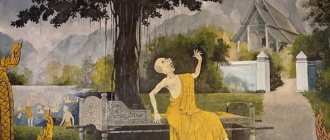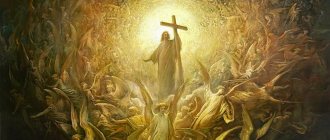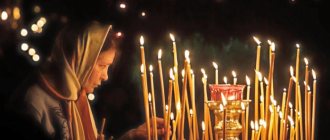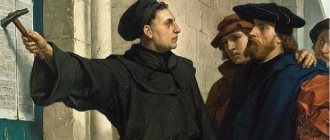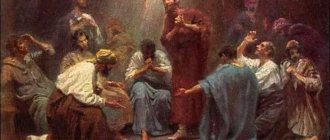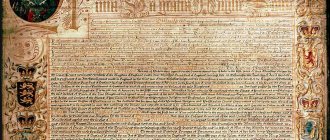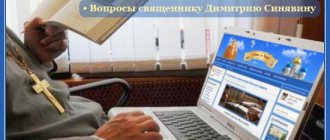The crucifix is a symbol of Christianity
Christianity
- the most widespread religion in the world, one of the three Abrahamic ones. Christianity was preceded by Judaism. On the basis of early Christian teachings, the third Abrahamic religion emerged - Islam.
Christians can be divided into several denominations:
- Ancient Churches of the East
- Catholics
- Protestants
- Orthodox
- Greek Catholicism and others.[1] There are also so-called Christian heresies - teachings that consider themselves to be Christianity, but do not recognize certain dogmas of other faiths.
- See History of Christianity, section on the Great Schism.
Christian teaching is based on the Old Testament, but to a greater extent on the Revelation received in the New Testament from the messiah - Jesus Christ, God, who was born in the human body, died and rose again, so that people could also be “resurrected” from the original sin inherited from the first people, Adam and Eve. The main values of Christianity are righteous life, meekness, and forgiveness. Every Christian must undergo the sacrament of baptism and not commit sins, but sincerely repent of their sins. Only then will he be able to enter the kingdom of the Lord, where eternal bliss awaits him. Unrepentant sinners are doomed to eternal torment. Christianity is also characterized by the missionary movement - converting people of other faiths to the Christian faith, both by preaching and by force, when the spread of faith carried political overtones.
Another characteristic concept of Christianity is the doctrine of the Trinity[2], the One God, the omnipotent creator of all things, who has three persons: God the Father, who cannot be seen, God the Son, who is also God the Word in a human body, and the Holy Spirit, depicted in the form of a dove. There are angels in the service of God, they are recognized with various titles (but they are not secured by dogma), that is, there is a hierarchy - archangels, cherubim, seraphim, ordinary angels. The church and clergy play the role of mediator between man and God, helping in the so-called salvation of souls. For almost two thousand years, churches have developed their own systems of ecclesiastical titles, subordinate to a strict hierarchy. There is a white, secular priesthood, and a black one, in which there are the titles of deacon, presbyter and bishop - the apostle’s protege, who is allowed to conduct any rites and sacraments of his church.
Holy Scripture and general dogma[edit]
Holy books[edit]
Old Testament
- the most ancient part of the Bible, borrowed from Judaism, written in Hebrew (some books in Aramaic). All confessions recognize the canonical Tanakh, 39 books written between the 13th and 5th centuries BC. e. A number of other books written later (the Second Book of Ezra, the Book of Tobit, the Book of Judith, the Book of the Wisdom of Solomon, the Book of the Wisdom of Jesus, son of Sirach, the Epistle of Jeremiah (included as the sixth chapter in the book of Baruch), the Book of the Prophet Baruch, the First Book of Maccabees, the Second Book of Maccabees , Third Book of Maccabees, Fourth Book of Maccabees), is recognized by the Catholic Church as a secondary canon, by the Orthodox Church - not coming from God, but righteous and instructive, by Protestants - most often apocrypha. Early Christianity used the Greek translation of the books of the Old Testament - the Septuagint. The books set out the history of the world from its creation and the ancient history of the Jewish people, and prophecies are also recorded in it. The Old Testament is considered the first Revelation to people from God. It is called Old because it is believed that Jesus Christ fulfilled the law given in it to its logical conclusion. Why did I conclude...
New Testament
- the second part of the Bible, but for Christians it is the most important, the key Revelation for this religion. Written in the 1st century AD. e. in Koine Greek, the widely used language of the Roman Empire at the time. 27 books, of which four are Gospels; Acts, Epistles, as well as the Revelation of John the Theologian (Apocalypse), permeated with mysticism.
- The Gospels are the accounts of the life of Jesus: his birth, earthly ministry, death, resurrection, and ascension. Recorded closer to the 2nd century AD. e., the apostles themselves are considered the authors in Christianity, which raises doubts. The Gospels of Matthew, Mark, Luke and John are considered canonical. The first three are, as it were, parallel to each other - they make up the Synopsis. The Gospel of John was written somewhat later and rather complements the synoptic ones. There are other works called Gospels, but due to discrepancies with the accepted canon, most confessions consider them apocrypha.
Apocrypha
- books that describe sacred events, but are not recognized as canon for some reason. The principle by which the Jews in ancient times determined which books should be included in the Tanakh, and which ones should be eliminated and destroyed, is not entirely clear. Apparently, those works that contained pagan motifs, such as witchcraft, or did not convey righteous thoughts were considered unsuitable. In the post-Christian era, the reason to consider a book apocryphal was often the anonymity of the work and the impossibility of establishing true authorship. The attempts of some authors to supplement the canon in their own way also became apocryphal. Catholics created registers of prohibited books, where apocryphal literature was entered, it was confiscated and destroyed (in those days when the church had such power). In Orthodoxy, a number of stories from the apocrypha were reflected in iconography and Tradition, even if their sources were not included in the canon.
Church dogmas[edit]
The revelations given to Christians from above are considered exhaustive for the salvation of human souls (although the Catholic Church has its own view on this issue), that is, their further speculation and logical development are not welcome. But it is difficult for weak human minds to comprehend the depth of biblical sayings. To the Church, then still united, this became clear when the first heresies appeared (at that time there was no such concept, because there were no dogmas that a heretic could violate - see “History of Christianity”). To combat them, the first Ecumenical Council was convened, which adopted the first Creed, and in it the first dogmas of Christian teaching.
So, dogma is a position of teaching accepted by the church as an irrevocable truth, unchangeable and indisputable. They appeared as a reaction to the distortion of God-given dogma, were adopted at the Ecumenical Councils and were supposed to direct the thoughts of believers in the right direction. Theologians can express their own opinion on the teaching - theogumen - in those aspects that do not concern dogmatics, but these will no longer be prescriptions, but a kind of recommendations. Within one denomination, dogmas are not applicable, but may differ among Christianity as a whole.
The dogmas of the first seven Ecumenical Councils are recognized by both the Catholic and Orthodox churches:
- Nicene-Constantinopolitan Creed
: God is the creator and ruler of all things; his essence is one, but he has three persons - God the Father, God the Son, the Holy Spirit; God the Father was originally, God the Son is born from God the Father, the Holy Spirit comes from God the Father (“filioque” - and from God the Son in the Catholic tradition); what birth and procession are is an incomprehensible mystery; Jesus Christ was immaculately conceived by the Virgin Mary and the Holy Spirit, endured earthly suffering and was killed by crucifixion, was resurrected and ascended (was taken into the kingdom of the Lord during his lifetime); every person must undergo the sacrament of Baptism once to save his soul; at an hour that man is not destined to predict, the second coming of God will happen, all the dead will rise in the flesh, and God will begin to carry out the Last Judgment on the entire human race, and then eternal life awaits him.
- Creed of the Council of Chalcedon
: in Christ there are two natures - Divine and human.
- Symbol of Faith of the VII Ecumenical Council (not recognized by all Protestants)
: icons of Christ, the Mother of God, angels and “all saints and reverend men” help the believer to more often remember those to whom they are dedicated, which means they are allowed to be painted.
The Catholic Church has adopted a number of its own dogmas, which are not entirely based on Holy Scripture. In addition, some dogmas, that is, unapplied truths, are found in the Holy Scripture itself, but they were not fixed by the Ecumenical Councils.
Main directions of Christianity: Orthodoxy, Catholicism, Protestantism
Christianity created the ideal of universal human behavior, their existence, a holistic worldview and attitude.
The basis of Christianity is the teaching about Jesus Christ - the God-man, the son of God, who came to people with good intentions, commanding them the laws of righteous life and accepting suffering and martyrdom crucified on the cross in atonement for human sins. Christians believe that the world was created by one eternal God, and there was no evil in this world. The resurrection of Christ marked for Christians victory over death and the possibility of eternal life with God. The main idea of Christianity was the idea of sin and human salvation. People are sinners in the face of God, this makes everyone equal, all people are sinners, all are God's servants.
Help with student work on the topic The main directions of Christianity: Orthodoxy, Catholicism, Protestantism
Coursework 470 ₽ Essay 240 ₽ Test paper 200 ₽
Receive completed work or advice from a specialist on your educational project Find out the cost
The Christian religion claims that suffering on Earth gives a person peace and heavenly bliss in the afterlife, and resistance to evil is the path to moral improvement.
Note 1
The main directions in Christianity are Orthodoxy, Catholicism, and Protestantism.
The reason for the split in religion is that, starting from the 4th century, Roman Christianity increasingly united with the state and absorbed its pro-pagan spirit. The Catholic Church, being based on the traditions of Rome, gravitated more towards Roman practicality and cruelty. Orthodoxy absorbed the spirit of Byzantium and gravitated towards sublime Greek philosophizing.
In other words, the two traditions had their origins in two different worlds - Greek and Roman, and therefore began to move away from each other.
Rituals, sacraments, holidays[edit]
Temple and liturgy[edit]
A Christian church, be it a basilica or a cross-domed church, is a kind of reduced model of the universe. There are vaults symbolizing heaven, the Holy Gifts - the flesh and blood of God, the hierarchy of clergy as a reflection of the hierarchy in heaven - the Lord and the angels surrounding him. All rituals performed inside a church or temple are intended to allegorically reproduce sacred events and thus get as close as possible to the kingdom of heaven, merge with it, enter it while being on earth. During a liturgy or mass, various rituals can traditionally be performed, prayers and sermons can be said, but all the variety of rituals is carried out with a common purpose, and the central part of the service in Orthodoxy, Catholicism and other historical churches is the moment of greatest unity with God - the sacrament.
Sacraments[edit]
In any religion, ritual helps a person communicate with God, whom he cannot see, in serving an immaterial force. However, in Christianity the so-called sacraments occupy a special role. This is not just a ritual; God himself invisibly participates in the sacrament. The New Testament deals with only two of them - baptism and the Eucharist, and only these two sacraments are officially recognized by the majority of Protestants. The rest arose over time. The ritual of the sacrament may differ in different denominations, for example, the number of immersions in water during baptism. In order for God to communicate His grace to those participating in the sacrament, the person must be filled with reverence, therefore the clergyman reminds each of those present about the importance of the ritual.
There are seven most commonly used sacraments in Christianity:
1. Baptism
- a ritual of pouring water over a person or completely immersing him in water. Initially it symbolized the death of a sinful person and his resurrection as a righteous man, ready to lead a new, pure life in order to be accepted into the kingdom of the Lord. The most important sacrament, without which a person is not allowed to participate in other sacraments. In order to be baptized, you must believe in God, which is why infant baptism is a controversial issue in Christianity. In Orthodoxy, it is considered necessary to baptize a baby, especially if there is a risk of his death, because God can help the child with his grace, and after death an unbaptized baby will not be able to enter the kingdom of the Lord, since sin lies with people from the very beginning. In this case, a godparent is selected who, with his faith, will help the baby to be baptized. Among Protestants of some movements, only baptism at a conscious age is considered correct. The ritual usually also includes a verbal formula that mentions the Trinity, the consecration of water, and anointing with oil.
2. Eucharist (communion)
- consecration of bread and wine (in Catholicism - only bread for the laity, bread and wine are intended for the clergy) with a special ritual and their consumption. This sacrament allows you to join God in Christ and is performed during the Divine Liturgy (or Mass for Catholics). In the Catholic and Orthodox churches, this sacrament can be performed either by the bishop or by a priest personally authorized by him. In Protestantism, it is often not considered a sacrament at all, but is used only as a symbol of communion with Christ. In other faiths, it is believed that during the Eucharist, bread and wine invisibly become the blood and flesh of Christ. In different movements of Christianity, both the ritual itself (the epiclesis prayer among the Orthodox or the “secret word” of Catholics, the need to place holy relics on the altar, etc.) and the technologies for preparing bread and wine differ.
3. Confirmation
- applying blessed oils to parts of a person’s body in a special way so that the grace of the Holy Spirit falls on the person. At the same time, a certain prayer is read. In Orthodoxy, it is performed immediately after baptism, as in Catholicism, but there it is not considered a sacrament, and the sacrament is anointing for the second time after 13-14 years, which is carried out in special cases for acceptance into the church and is called confirmation. Protestants also have confirmation, but it is not confirmation. There is also the anointing of a ruler to the kingdom, but for obvious reasons it is no longer carried out.
4. Repentance (confession)
- recognition of one’s sins and repentance before God, whose face is the priest. The sins of which the believer has repented will be forgiven. In Orthodoxy, a person confesses either during the service (accordingly, those present can hear him), or at a time appointed by the priest. In Catholicism, confession is also mandatory: once a year, preferably more often. It is customary for them to set up confessional rooms in which a cloth is stretched between the priest and the penitent so that the face is not visible.
5. Blessing of Unction
- applying oil (olive oil) to the patient's body to alleviate his suffering. Illness can be a physical illness or a mental illness, but not violence. The person must be conscious.
6. Ordination (priesthood)
- the sacrament of initiation into the church dignity by the successor of the apostle, that is, by the bishop. It is performed by placing hands on a person’s head, as Christ did. In Orthodoxy, when consecrating a bishop, the Gospel is placed on the head. Initiation rites differ in different faiths, but not significantly.
In connection with this sacrament, we will also consider such a phenomenon as apostolic succession. Let’s take, for example, the most ordinary Orthodox priest. When did he become a priest, that is, a person entitled to perform the sacraments? Not upon graduation from seminary, but only when he was ordained
to this by the bishop. This bishop, in turn, was also not born with this right, but was ordained by a third bishop even earlier, and that bishop even earlier... And our priest, if he rises to the rank of bishop, then he himself will be able to ordain young seminary graduates. So, the essence of apostolic succession is that for any priest, including the most seedy priest from the most seedy parish, this continuous chain of ordinations can, at least theoretically, be traced back centuries to Jesus Christ himself, who ordained His 12 disciples. Orthodox and Catholics strictly adhere to this rule. Since the time of Martin Luther, Protestants have not considered apostolic succession as a mandatory requirement for the priesthood (which is why the Orthodox from the first two branches refuse to recognize them as Christians). However, not all: Scandinavian Lutherans and Anglicans initially preserved it, and later it was restored from them in some other Protestant denominations.
7. Marriage
- a ceremony for the marriage of a man and a woman. It was borrowed from the Greeks during the time of persecution of Christians and reworked. Currently, believers do not have to marry according to church customs, however, these rituals are still performed. In Orthodoxy, the sacrament of marriage consists of betrothal (usually occurs immediately before the wedding), wedding (as in ancient times, wreaths are placed on the heads of those getting married) and drinking from a common cup. This is usually followed by a liturgy. Weddings can only take place on certain days when there are no important fasts or holidays. Catholics do not have weddings, but some customs are stricter: the desire to get married is announced three months in advance, divorce is not provided for, a second marriage is possible only if one of those married dies, children will need to be raised in Catholicism, even the infertility of one of them can become an obstacle spouses. Among Protestants, marriage is not considered a sacrament.
This list is accepted as a dogma by Catholics, but in other faiths others can be added to these basic sacraments - for example, burial can also be included in them.
Holidays[edit]
Celebrations of various memorable dates existed back in the days of the first primitive calendars. With the introduction of peoples to Christianity, these holidays going back centuries were not forgotten; they could only gradually be replaced and supplanted by new holidays. Therefore, in different churches, the dates of holidays and fasts, restrictions on various types of food, as well as the essence of their celebration may differ significantly. However, there are key holidays common to most Christians that mark events of particular importance:
- Christmas
is the birth of the Messiah Jesus Christ by the Virgin Mary, a constant date. The birthdays of saints are also called Christmases (this word is Church Slavonic), but they are rarely celebrated - for example, the Nativity of the Virgin Mary or John the Baptist. - Easter
is the most important holiday of Christianity, dedicated to the Resurrection of Christ.
Celebrated on the first Sunday after the spring full moon, that is, the date is moving. Corresponds to the more ancient holiday of Passover among the Jews, and was made floating, in particular, in order to dissociate itself from them. Easter is preceded by Great Lent
- forty days dedicated to the memory of Christ's stay in the desert, and
Holy Week
, dedicated to Christ's stay in Jerusalem before his execution.
In Catholicism, Holy Day is considered part of Lent; in Orthodoxy, it ends on the last Friday before it. Lazarus Saturday
is the day of the resurrection of Lazarus as a prototype of the future general resurrection. - Vai week
aka
Palm Sunday
(in Russia and neighboring countries
Palm
) - the entrance of the Lord into Jerusalem. The Jews, greeting Him as King, threw palm branches at His donkey’s feet. - Maundy Monday
is a remembrance of the Old Testament patriarch Joseph, who was sold into slavery in Egypt, and of Jesus’ curse on the barren fig tree. - Maundy Tuesday
is a remembrance of the parables of Jesus and His denunciation of the scribes and Pharisees. - Great Wednesday
is a memory of the repentant sinner (in Catholicism it is believed that Magdalene) who anointed the feet of Jesus with myrrh, and of the betrayal of Judas. - Great
, also known as
Maundy Thursday
, is the day of the Last Supper, prayer in the Garden of Gethsemane and the kiss of Judas. - Good Friday
- Pilate's trial and crucifixion. - Holy Saturday
is the burial of Christ, His descent into hell and the removal of the righteous from there.
- celebrated on the fortieth day after Easter, dedicated to the ascension of Christ into the kingdom of heaven.
is the day when an angel (it is believed that Gabriel) announced to the Virgin Mary that Christ would be born from her, a constant date.
